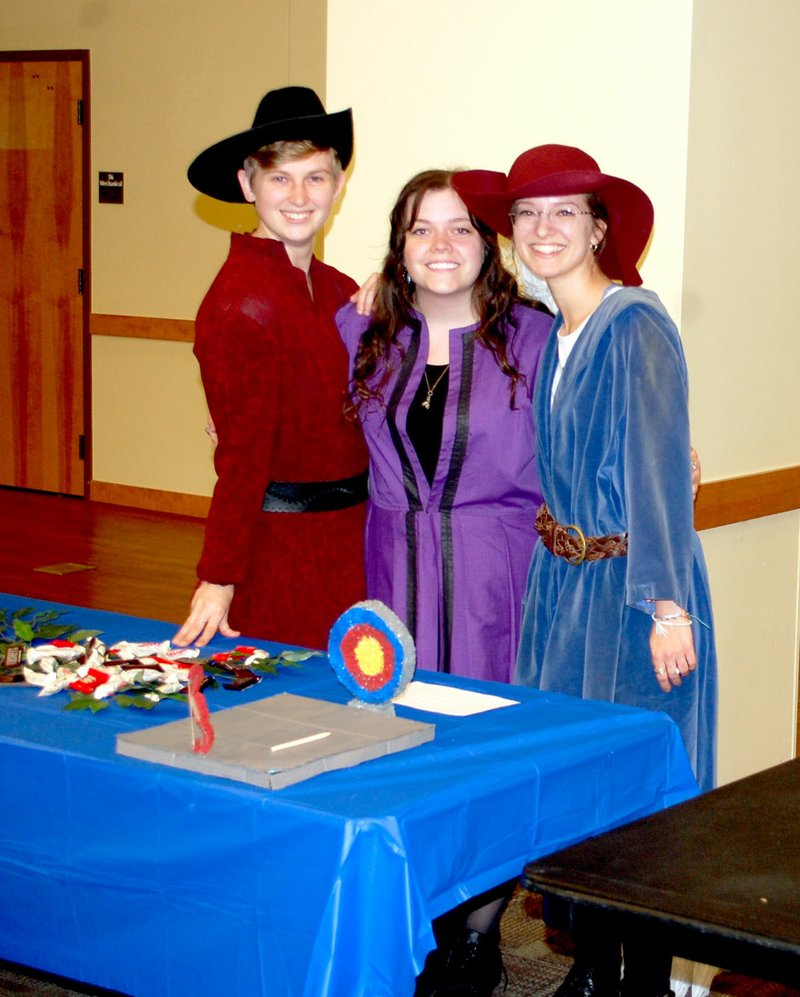People had the chance to battle monsters, hunt the Great White Stag, pet a werewolf and join a pair of minstrels as they sang a heroic tale during the Medieval Faire on Nov. 25 at John Brown University's Great Simmons Hall
The Medieval Faire was presented by professor Jonathan Himes' Medieval Literature class in conjunction with JBU's History Club, according to Himes. The event featured activities and exhibits centered on the Middle Ages.
Exhibits included the Battles of Beowulf, a Breton Werewolf Lai, Legends of Wales, Robin Hood the Yeoman Host of the Greenwood, and Wandering Minstrels, according to Himes. There was also a table of toys with a medieval theme, a crossbow demonstration by retired professor David Cater and a table of food that was served during medieval times such as meat pies, and bread and cheese.
"It's a great way to bridge what they've learned, not just to write another paper... but bring it to life in another way," Himes said.
The Battles of Beowulf was an interactive exhibit that offered participants a chance to sail the seas to the land of the Danes, crawl through a spooky cavern to the lair of the monster Grendel and fight King Hrothgar, also known as junior Matthew Newton.
The Breton Werewolf, is a tale from A.D. 300, according to senior Eden Pierce. The display featured Pierce, senior Caleb Place and Luke, a Labrador retriever playing the part of the werewolf.
The premise of the story is of a man who continually transforms into a werewolf and can only turn back to human form when he has clothes on, Pierce said. One night the wife steals his clothes so she can be with another man, according to Pierce.
The werewolf is discovered by a king, who befriends the werewolf, Pierce said. Eventually the king discovers the werewolf's identity and helps him to regain his human form, he said. The man becomes the king's loyal subject, but not before biting off the nose of the woman who stole his clothes, said Pierce. He added that the woman was banished from the land and went on to have generations of nose-less children.
The Legends of Wales exhibit was based on the Mabinogion and was presented by juniors Stewart Sherman, Lydia DeGisi and Coburn Dolloff. The Mabinogion is a collection of Welsh prose tales from 12th and 13th centuries. The word Mabinogion means tree and and the stories in the series are referred to as branches, according to Dolloff. The stories were told in the form of games that participants could play, Dolloff said.
The first tale is about a man and his wife who capture another suitor and put him in a bag then beat him up, Dolloff said. The couple then pretends to have created a game called badger in a bag where people beat the bag with the suitor in it thinking a badger is inside, Sherman added. Attendees who hit the bag with a stick get to keep the candy that falls out, he said.
The second story centers around a king who was hunting the Great White Stag on another king's land, who also happened to be the Lord of the Underworld, Sherman said. The two kings happen upon each other and the second king realized that the first king was hunting on his land without permission, he said. As penance, the two kings switch places for a year.
"I went and lived in his kingdom for a year and he lived in mine," Dolloff said. "We give participants a chance to reenact that."
Participants were given the chance to shoot arrows at the stag portrayed by Sherman.
The last tale that was featured involved a magic cauldron, Dolloff said. The cauldron was supposed to reanimate the dead and the king used it to bring his soldiers back to life, he said. Participants got to throw in the last needed body part to reanimate a soldier, he said.
The tale of Robin Hood presented at the fair was a different version than most people are used to hearing, according to seniors Kaitlyn Bullington, Karis Martin and Peyton Hoffman. Martin said that this tale spoke more about class structures and told of a Robin Hood who did not rob from the rich and give to the poor, but rather just robbed from the rich.
Martin added that this Robin Hood was of a lower class but was also a bowman and hunter, which was something only nobility did. Martin added that the effects of the Black Plague and peasant revolts were also discussed. A small target was set up for people to try their bow and arrow skills.
The Wandering Minstrels featured seniors Callie Huston and Elijah Weaver singing songs from the Middle Ages and demonstrating some of the instruments from that time period, including a dulcimer and some flutes.
"A minstrel is a traveling musician that is used for cultural function and entertainment, so the earliest form of it was used mostly for historical (pieces)," Weaver said.
Between the 13th and 15th centuries minstrels were extremely popular and each town would eventually have their own minstrels, Weaver said. Minstrels also functioned as nightwatchmen, Weaver said. The minstrels were required to blow loud instruments to warn the townspeople of intruders.
General News on 12/04/2019

